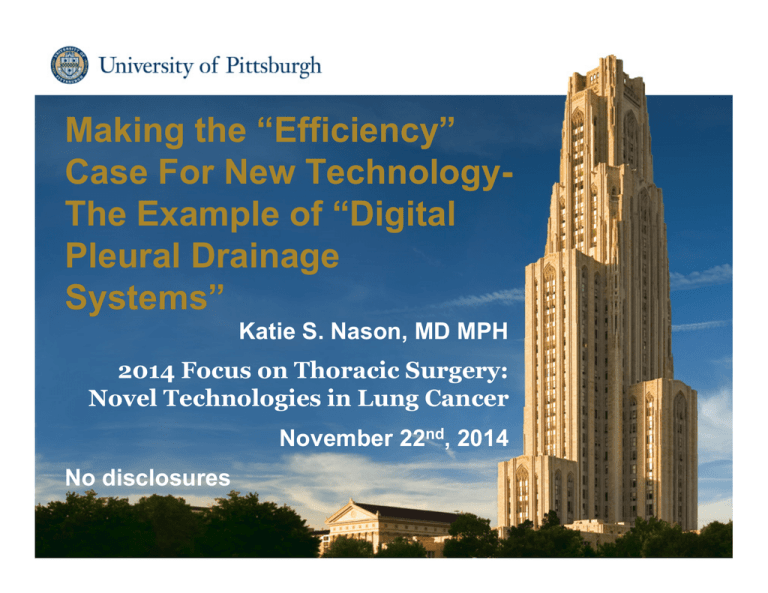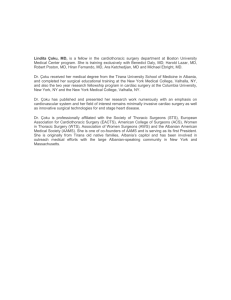Presentation
advertisement

Department of Cardiothoracic Surgery Making the “Efficiency” Case For New TechnologyThe Example of “Digital Pleural Drainage Systems” Katie S. Nason, MD MPH 2014 Focus on Thoracic Surgery: Novel Technologies in Lung Cancer November 22nd, 2014 No disclosures Department of Cardiothoracic Surgery Efficiency is concerned with the relation between resource inputs (costs, in the form of labor, capital, or equipment) and either intermediate outputs (numbers treated, waiting time, etc) or final health outcomes (lives saved, life years gained, quality adjusted life years (QALYs)). Palmer, S. and D. J. Torgerson (1999). "Economic notes: definitions of efficiency." BMJ 318(7191): 1136. Department of Cardiothoracic Surgery Definitions • Technical efficiency refers to the physical relation between resources (capital and labor) and health outcome. • Productive efficiency refers to a situation where one intervention produces the same (or better) health outcome with less of one resource and more of another. • “Avoiding waste, including equipment, supplies, ideas, and energy” IOM Department of Cardiothoracic Surgery Are health care resources being used to get the best value for the money in the management of prolonged air leak • Problem: Prolonged air leak after lung resection • Resource input: Pleural drainage device • Health outcomes: – Duration of chest tube drainage – Need for reinsertion of chest tube – Hospital length of stay Department of Cardiothoracic Surgery Analogue Pleural Drainage Systems • Static analogue system for estimating volume of air leak – Inter- and intra-observer variability Varela G, et al, Eur J Cardiothorac Surg 2009;35:28—31. – Highly subjective – Dependent on patient cooperation/understanding – Single snap-shot with each observation – Cost ~ $600 Department of Cardiothoracic Surgery Digital Drainage Systems • Quantify air leak continuously • Quantify volume of air leak (ml/min) and aggregate data over time • Measure intrapleural pressures Department of Cardiothoracic Surgery Randomized comparisons: Digital vs analogue • 4 randomized trials (2 with lobectomy only) – Bertolaccini, L., et al. (2011). Eur J Cardiothorac Surg 39(5): e128-132 – Cerfolio, R. J. and A. S. Bryant (2008) Ann Thorac Surg 86(2): 396-401 – Brunelli, A., et al. (2010). Eur J Cardiothorac Surg 37(1): 56-60. – Filosso, PL et al (2010). J Cardiovasc Surg 51: 1-5. Department of Cardiothoracic Surgery Do digital drainage systems give the best value for the money with regard to TECHNICAL efficiency? Maximum possible improvement in outcome is obtained from a set of resource inputs. Surgery Total n CT days LOS DPV APV DPV APV Bertolaccini (2011) *FEV1>70% n=98 (49/49) Wedge/seg /lobectomy 3.1/5.5 3.5/6.1 6.5 7.1 Cerfolio (2008) *all PFTs n=100 (50/50) Wedge/seg /lobectomy 3.1 3.9 3.3 4.0 Filosso (2010) *FEV1 50-70% n=31 (15/16) Lobectomy 3/5 3/4 9 6.5 Brunelli (2010) n=166 (82/77) Lobectomy 4 4.9 5.4 6.3 Department of Cardiothoracic Surgery Do digital drainage systems give the best value for the money with regard to PRODUCTIVE efficiency? One intervention produces the same (or better) health outcome with less of one resource and more of another. Air leak D1 Air leak D2 Air leak D3 Total DPV APV Total DPV APV Total DPV APV Bertolaccini (2011) 47 (48) 26 (53) 21 (43) 22 (22) 12 (24) 10 (20) 11 (11) 6 (12) 5 (10) Cerfolio (2008) 44 (48) 23 (46) 21 (42) 21 (21) 11 (22) 10 (20) 11 (11) 6 (12) 5 (10) Filosso (2010) not reported not reported not reported Brunelli (2010) not reported not reported not reported Department of Cardiothoracic Surgery Which patient may benefit? Predictors of postoperative prolonged air leak – Reduced predicted postoperative forced expiratory volume in 1 second <80% – Upper resections – Presence of pleural adhesions – Steroid use – Older age (>65 yrs) – Lobectomy – Male sex – Normal BMI Brunelli, A., et al. (2004). Ann Thorac Surg 77(4): 1205-1210; Cerfolio, R. J., et al. (2002). Ann Thorac Surg 73(6): 17271730; Brunelli, A., et al. (2010). Ann Thorac Surg 90(1): 204-209. Department of Cardiothoracic Surgery % PAL Which patient may benefit? Predicting risk 40 30 20 10 0 29 1.4 0 Class A (score 0) 5 6.7 12.5 25.7 10.9 Class B (score 1) Class C (score 1.5- Class D (score >3) 3) Risk Classification Development Validation Brunelli, A., et al. (2010). Ann Thorac Surg 90(1): 204-209. Department of Cardiothoracic Surgery Improving risk stratification • Age, FEV1%, FEV1/FVC ratio, DLCO%, COPD, Side of operation, upper vs lower, air leak flow (ml/min), maximum pleural pressure and minimum pleural pressure • Digital measurements 6 hours postoperative • Flow and ∆p independently predictive • Validated in an external dataset Brunelli, A., et al. (2011). Eur J Cardiothorac Surg 39(4): 584-588. Department of Cardiothoracic Surgery Summary • The majority of patients do not have prolonged air leak after lung resection • Likelihood of prolonged postoperative air leak can be estimated intraoperatively – Suboptimal; 1 or more present in most patients • Air flow and pressure differential independently predictive of prolonged air leak in early postoperative period Department of Cardiothoracic Surgery Conclusions • Routine use of digital systems provides technical but not productive efficiency • Data suggest that Thoracic Surgeons can improve postoperative efficiency after lung resection through risk stratification. • Selective use of digital drainage systems in high-risk patients may be justified Department of Cardiothoracic Surgery Making the “Efficiency” Case For New TechnologyThe Example of “Digital Pleural Drainage Systems” Katie S. Nason, MD MPH 2014 Focus on Thoracic Surgery: Novel Technologies in Lung Cancer November 22nd, 2014 No disclosures



